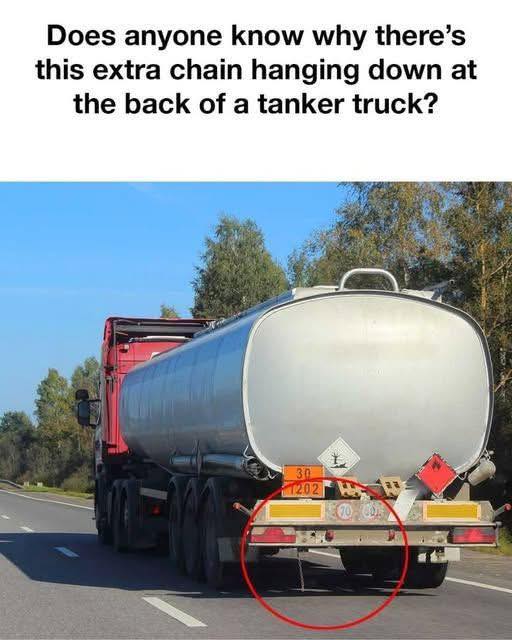If you’ve ever driven behind a fuel tanker, you may have noticed something unusual dangling near the rear bumper: a short length of metal chain dragging along the road. At first glance, it might seem like just a loose piece of hardware left behind by a careless mechanic. But in reality, this chain is a crucial safety feature—a simple yet highly effective tool designed to prevent tragedy.
The Role of the Grounding Chain
Tanker trucks are purpose-built to transport liquids and gases such as gasoline, diesel, chemicals, water, and even food products like milk or corn syrup. The cylindrical tanks mounted on heavy-duty chassis are engineered with one primary goal: containment and the safe delivery of their volatile cargo. Yet, even with robust engineering, one invisible hazard always lurks—static electricity.
As a tanker moves down the road, friction between the liquid inside and the tank walls, combined with normal vehicle vibration and airflow, generates static charges. Under the wrong conditions, these charges can reach dangerous levels. A single spark near flammable vapors could ignite a fire or even cause an explosion. The dragging chain provides a constant path for these charges to safely dissipate into the ground, neutralizing the risk before it can cause disaster.
The Origins of the Practice
This is not merely a modern precaution. In the early decades of bulk fuel transport, catastrophic fires were not uncommon. Investigations often traced accidents back to static buildup inside the tanks. As the petroleum industry matured, safety engineers realized that something as simple as grounding could drastically reduce risk. The grounding chain emerged as one of the cheapest, simplest solutions and quickly became standard practice. By the mid-20th century, regulations in multiple countries required static-control measures, embedding the dangling chain into global fuel transport culture.
The Science Behind Static Control
Static electricity occurs when two materials come into contact and then separate, leaving one positively charged and the other negatively charged. In a moving tanker, the liquid sloshes against the tank walls, creating countless contact-and-separation events. These charges accumulate until they seek release. Without grounding, that release can happen in the form of a spark—a serious hazard in the presence of fuel vapors.
The grounding chain works on a simple principle: conductivity. By maintaining constant contact with the road surface, the chain provides a low-resistance path for electrical charge to escape continuously. Instead of building up to dangerous levels, the charge “bleeds off” into the earth in real time. It’s passive, reliable, and requires no intervention from the driver—exactly the kind of redundancy critical in hazardous materials transport.
Beyond the Chain: Modern Safety Layers
Although the chain remains widely used, it is no longer the only line of defense. Modern fleets often employ multiple static-control strategies:
Grounding reels with retractable cables are clipped to verified ground points at loading terminals, ensuring tanks are bonded before fuel is pumped.
Anti-static additives are sometimes mixed into fuels to reduce charge buildup during transit.
Specialized linings and coatings inside tanks minimize friction between the liquid and metal surfaces.
Bonding straps ensure all parts of the truck and trailer maintain equal potential, preventing sparks when different metal sections come into contact.
These layers do not replace the chain—they complement it. The chain continues to provide protection during transit, while reels and additives handle the loading and unloading process, when risks are often highest.
Misconceptions About the Chain
Because it looks so ordinary, the dragging chain has often been misunderstood. Some people assume it helps with braking, stabilizes the trailer, or is just an old relic no longer needed. None of that is true. The chain’s sole purpose is to control static electricity. Far from being outdated, it still plays a crucial role, even in fleets that use more advanced equipment.
Maintenance and Inspections
Like any safety feature, the chain only works if it’s properly maintained. Dirt, rust, or broken links can reduce conductivity. If the chain is cut too short to maintain constant contact with the ground, its effectiveness is compromised. That’s why regular inspections are critical. Drivers and inspectors are trained to check that chains are intact, securely fastened, and making reliable ground contact. Replacing a worn chain is quick and inexpensive—far cheaper than the potential consequences of ignoring it.
Why Small Details Matter
Fuel tankers travel through cities, neighborhoods, and highways every day, often carrying thousands of gallons of highly flammable cargo. Even a marginal improvement in safety can save lives. The humble grounding chain, though barely noticeable, is a textbook example of how small details in engineering can carry outsized importance.
In a world of increasingly high-tech solutions, this simple steel link continues to prove its worth. It quietly does its job mile after mile, bleeding off static, preventing sparks, and complementing a broader safety system designed to protect not only drivers and operators but also the public.
Conclusion
The next time you find yourself driving behind a tanker and see that chain dragging on the pavement, understand this: it’s not a mistake, nor an afterthought. It’s a silent guardian. Born out of past tragedies, refined through decades of regulation and best practices, and still essential today, the chain is an unsung hero of highway safety. In the high-stakes world of hazardous materials transport, sometimes the simplest tools are the most effective—and the most enduring.
